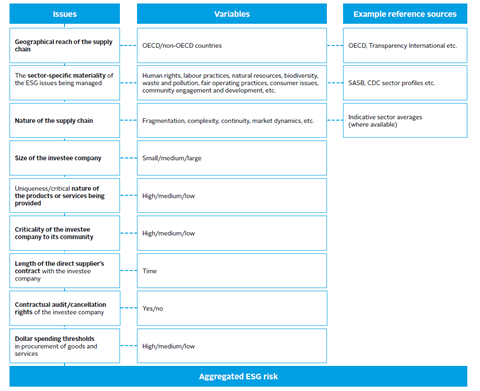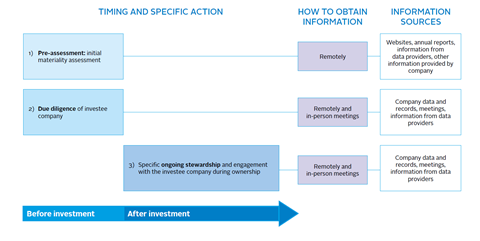This article contains questions that investors can ask investee companies pre or post-investment.
The questions focus on ESG risks and opportunities in the investee company’s supply chain. It is also designed to encourage the investee company to develop appropriate monitoring procedures where they are lacking.
The list of suggested questions is not intended to be exhaustive, nor to replace existing due diligence frameworks, but rather to supplement them. Not every question will be relevant to every type of investee company or asset.
The questions cover:
- company policies and processes (ideally formal procedures) relating to identifying and managing ESG issues in the supply chain;
- specific ESG issues based on materiality to the investee company in question, and a deep-dive on these issues where necessary;
- implementation and practice of ESG management within the supply chain.
The questions are intentionally broad, allowing investors to focus on what they consider to be the most material ESG issues. Appropriate questions may change based on a number of factors including sector materiality, company practices and time horizons; for example, between development, construction and steady-state operations or over the life cycle of an infrastructure investment.
Practical considerations for starting engagement
Moving from initial stages to a more developed approach to supply chain risk management
With the nature of supply chain risks being difficult to address and resolve, it is important to begin the process of understanding and managing them instead of ignoring them. Rather than expecting best practice to exist and be achieved instantly, investors should aim to encourage companies’ commitment to continued improvement as they move from initial stages of supply chain risk management to a more developed approach, as highlighted by Table 1 below.
| Starting point for companies | Developed approach for companies |
|---|---|
| Limited visibility over supply chain | Mapped-out supply chain and encouragement of tier one suppliers to engage with those further down the chain |
| Transactional relationships with suppliers likely to have major emphasis on short-term cost, resulting in the potential for reduced trust and loyalty | Rewarding suppliers that improve with more business and continually allowing them to invest in improvements with confidence |
| Conflicting interests between procurement and sustainability teams | Streamlining of interests of procurement and sustainability teams |
| Engagement with suppliers focused on audits | Strengthened relationships between company and suppliers, moving from auditing alone to more regular interaction |
| Limited collaboration with other stakeholders | Confidential grievance mechanisms so that suppliers can voice any suspected ESG breaches anonymously |
| Limited disclosure about supply chain standards and supplier details | Openness and transparency of supplier base, including any challenges/issues identified |
| Policies typically focus on legal compliance only | Seeking feedback and input from external stakeholders and policies going beyond legal compliance alone |
An investor can obtain the following information as initial steps towards engaging on supply chain management with its relevant portfolio companies.
- What is the company fs current visibility of their own supply chain?
- What is the current nature of relationships between the company and its suppliers?
- How is supply chain engagement managed between internal procurement and sustainability functions?
- To what extent does the company audit its supply chains?
- To what extent does the company collaborate with other stakeholders related to ESG issues?
- Which existing supply chain policies are in place?
Prioritising action on ESG risks and opportunities in the supply chain
Investors need to prioritise action and engagement on ESG risks and opportunities based on materiality to the company and, in the case of risks, the severity of the potential adverse impacts.
Investors should develop questions relevant to their own requirements and the nature of the investee company. This should be tailored rather than a check-box approach. There is no definitive list of right or wrong questions.
Figure 2 provides an example framework of issues, variables and references to use as a starting point.
What to ask and when
Which questions to ask depends on the stage of the investment process below (shown in Figure 3):
- The pre-assessment will provide indicative measures and establish an understanding of the supply chain risks and opportunities specific to the potential investee company, before asking the company more detailed questions during the initial investment due diligence.
- During due diligence, questions are likely to focus on basic governance issues, performance, and may provide red flags to inform the investment decision or produce a time-bound action plan to close performance gaps.
- During ongoing stewardship and asset management, engagement on supply chain ESG risks is likely to be deeper to encourage performance improvements. Establishing goals with investee companies may be easier for majority shareholders and those holding board seats.
Co-investors should look to collaborate, wherever possible, to aggregate their influence over investee companies and streamline engagements to avoid reporting fatigue.
The questions proposed for due diligence (initial investment) and during ongoing ownership and stewardship (post investment) are addressed in the same questionnaire below.
Supply chain activities generally look relatively different during development, versus construction, versus operations. The ESG risks and opportunities may therefore need to be considered differently in each stage. Furthermore, an investor needs to consider what should be required.
Delilah Rothenberg, Pegasus Capital Advisors
Download the full report
-

Managing ESG risk in the supply chains of private companies and assets
November 2017
Managing ESG risk in the supply chains of private companies and assets
- 1
- 2
 Currently reading
Currently readingHow to engage with companies
- 3
- 4
- 5
- 6
- 7
- 8

















